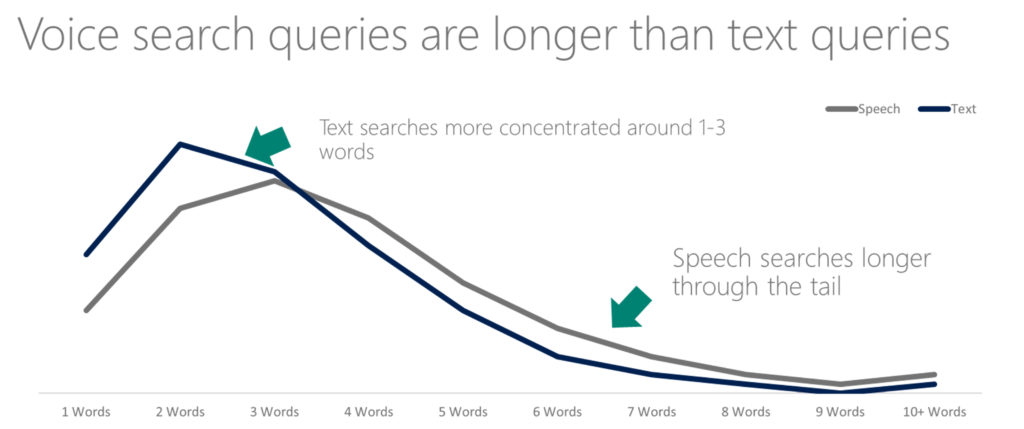Voice Search: What You Need to Know About This New SEO Frontier


Siri, Alexa, and “Okay Google” are now part of our daily lives as voice search becomes increasingly popular.
More than 40% of adults used voice search on a daily basis in 2016 and ComScore predicted that by 2020, 50% of all searches will be voice searches.
Thanks to advance in AI and natural language processing technologies, the “direct answers” from voice search reflect how people ask questions in speech – which is often quite different from the way users type a keyword-driven query into a search bar.
What does this mean for marketers who want to stay on top of their SEO game and get found by prospects who use voice search?
What changes do you need to make to your SEO strategy?
Optimizing for voice search can be more challenging because users won’t be shown pages of search results. Instead, digital assistants will only deliver the top one(s).
With voice search, businesses are facing even more pressure to get their SEO dialed in.
As such, you need to understand how voice command changes the way people search and then optimize your content to cater to these behaviors.
How Is Voice Search Different?
When users ask a question verbally, they phrase it differently than when they type it into a search bar.


Here are some characteristics of voice search that’ll affect how you optimize your content:
- Complex queries: Google’s RankBrain takes context into account and understands complex queries. This means keyword targeting strategies need to focus on longer keywords/phrases and overall topics.
- Audio-only interfaces: as users are discovering information, making purchases, or interacting with websites using only voice, we need to reconsider the role of text and visual medium when presenting information on websites.
- Shorter interactions: voice searches are typically used to get quick answers rather than for long research sessions. That means you’ll have less time and fewer opportunities to make an impression.
- Increase in importance for top positions: for short-duration queries, digital assistants typically only present top-position entries. Getting the top ranking for a given search engine results page (SERP) becomes even more critical.
- Local results: as many people use voice search on mobile while they’re on the go, these searches are also more likely to have a local intent. This means you need to optimize for local SEO if you have a brick-and-mortar store.
Top 11 Ways To Optimize Your Content For Voice Search
As consumers are quickly adopting voice search, it’s time to reevaluate your SEO strategies to make sure your content is visible and relevant across all formats for both text and voice searches.
Here are 11 ways to make sure your content is optimized for voice search:
1. Answer Your Audience’s Questions
As search engines are putting more emphasis on semantic keywords, intent and context, your content needs to reflect the users’ thought process throughout their customer lifecycle.
Understanding how your ideal audience phrase their questions can help you write in a natural and conversational tone while using terms that signal relevancy to search engines.
2. Understand Search Intent
To create the most relevant content, it’s important to understand the intent and context of a query.
Include long-tail keywords when optimizing your content to deliver the most helpful information to your audience in a way that matches the various stages of their customer journey.
3. Use Schema Markup on Your Website
Search engines use schema markup (also called structured data) to efficiently crawl website content. In short, schema markup tells search engines what your data means.
By integrating structured data at the backend of your website, your content will become part of the available knowledge graphs and more likely rank high in search results.
4. Optimize Featured Snippets
Often times, when users type a question into Google, they’ll see an “answer box” with a paragraph or a series of bullet points above the search results.
This placement is often referred to as “position zero.” Currently, Google Home and Google Assistant are programmed to read the featured snippet from sites that are granted “position zero” on SERP.
To optimize your feature snippet, create content that clearly answers a question frequently asked by your customers. Then make sure your codes are clean and content is tagged properly so Google can easily understand the information.
In addition, voice search results tend to be very brief and to-the-point so make sure that your answer snippet is as concise as possible while providing a thorough and relevant answer.
5. Improve Page Speed
Google’s voice search algorithm uses page speed as a ranking signal and the typical loading speed of a voice search result is faster than most webpages.
You can improve page load speed by enabling compression, minimizing server response time, optimizing images, reducing redirects, and minimizing code.
6. Improve Your Site’s Link Authority
In a voice search, Google is only giving a single answer so it needs to be certain that it’s providing users with the most accurate information.
It does so partly by evaluating the domain authority (DA) of a website to ensure that it’s a trusted source.
To increase your DA, you should build high-quality backlinks, create relevant content, and improve both on-page and off-page SEO.
7. Publish Easy-To-Read Content
When ranking for voice search, Google considers the ease of understanding an answer in spoken form.
Simply put, if your answer is written in a way that’s hard to comprehend when in speech, your ranking will be impacted.
Use simple language and short sentences to ensure that your content is easy to understand.
Also, pay attention to the reading level of your content – Backlinko has found that the average voice search result is written at a 9th-grade reading level.
In addition, make sure that your voice search answers can be easily understood without any visual reference.
8. Create Long-Form Content
Backlinko also found that most voice search results come from pages with a high word count (over 2,000.)
Even though Google may not be specifically looking for long-form content, high word-count allows more opportunities for getting a “match” in a voice search.
The structure of the content also plays a role in voice search SEO.
For example, FAQ pages tend to do well because a lot of voice searches are long, question-based queries – the exact format that’s likely to appear on an FAQ page.
9. Improve SERP Ranking For Specific Keywords
The higher a page ranks for specific keywords, the more likely it’d be chosen as the voice search result because Google wants to use content that’s proven in traditional desktop SERPs to ensure the quality of the voice search answers.
Therefore, it pays to optimize your content for specific keywords as it’ll benefit your SEO for both desktop and voice searches.
10. Optimize For Mobile Searches
Voice searches, which are often done on mobile devices, tend to have higher purchase intent when compared to desktop searches.
For example, queries such as “store hours” or “near me” are mostly performed on mobile devices.
In addition, GPS and other mobile-specific technologies are changing how people use search on mobile.
11. Optimize For Local SEO
Most voice searches are done on mobile when users are looking for products or services in their local area.
By optimizing for local SEO, you’ll have a better chance of getting found on voice searches.
Make sure to include your location in the keywords, leverage the power of online directories, claim and optimize Google My Business, and get good online reviews from your happy customers.
Conclusion
Voice search is still a relatively new territory in SEO and Google will be refining its ranking criteria as more people use voice assistants to look for information.
Since most voice searches only present one top result, it’s more important than ever to hone in on your SEO.
To get ranked for voice searches, you have to create high-quality content that’s not only relevant but also in languages used by your target audience.
Keeping up with the fast-evolving voice search SEO best practices could be a lot of work – even for full-time SEO experts!
To ensure that your ideal customers can find your business on voice searches, consider investing in a professional SEO service so you can implement the latest strategy to stay ahead of your competition.
Recent Posts
Ways To Embrace Seasonal Content Marketing
Think Big SEO - X Ways To Embrace/Use Seasonal Content Marketing Content creators constantly strive…
5 Mistakes To Avoid When Starting a Business
Starting a business is a challenging endeavor even when each step is taken correctly. That…
3 Easy Ways to Improve Law Firm SEO
The legal industry is a competitive one and as such, law firms sharing a single…
Dental SEO Marketing Strategies You Should Use
It can be difficult to ensure that one specific dental office gains the most visibility…
SEO for Doctors and Doctors’ Offices
Search engine optimization is not always a straight-forward, easy process, especially for business professionals who…
Tips for Better Real Estate SEO
Search engine optimization is not an easy process to perfect, especially due to the fact…


